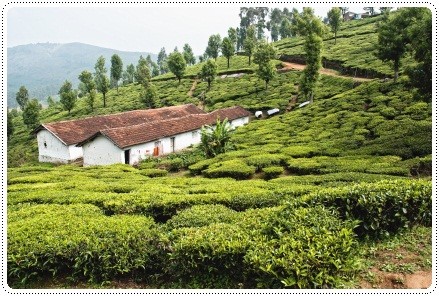Backpackers' Introduction to
Weather in India
"Weather in India" was last updated on March 05, 2012
All information below is subject to change
Quick links:
In terms of size and landscape, India is vast and enormous. This also means that there are strong regional varieties in the climate and weather.
It ranges from the hot and dry deserts in Rajasthan to the tropical and humid climate in south India.
From snow in the north to constant sweating in the south.
India's climate can be roughly divided into three seasons: hot season, wet (monsoon season) and dry (winter) season.
The hot season is from March to May, wet season is from June to October, and the dry season is from November to February.
In this article I introduce you to the weather in climate in the most important regions/cities/towns, with a (short) description of how the climate actually is.
All temperatures written below are average celsius temperatures (unless otherwise specified)
Average temperatures are given because I don't have the capacity to give you the exact temperature at any given time.
Trends on average temperatures and heaviest rainfalls give you guidelines on when you should travel to specific destinations in the country.
Read my conclusion at the bottom, where my specific recommendations are listed.
Weather in Delhi
North India
November-February: minimum 7.5°, maximum 28.1°
March-May: minimum 15.5°, maximum 39.5°
June-October: minimum 19°, maximum 38°
Heaviest rainfalls: August and September
Absolute maximum temperature (not average): 47° (in June)
Absolute minimum temperature (not average): -0.8° (January)
Source: meoweather.com
I've been to Delhi twice, in October and March. March was really hot during the daytime, and pleasant in the evening. Visiting Delhi in October was a little 'colder', but still hot during daytime.
Weather in Rajasthan
North India
In Rajasthan (desert region), it doesn't really rain much compared to other destinations in India, like Delhi or Kolkata. I traveled in Rajasthan in October and March, and it was way hotter in March. October was more pleasant.
I spent almost a week in Jaipur in March, and most days were sunny. The climate was likewise in Pushkar when I was there during the hot season.
Jaipur
November-February: minimum 8°, maximum 30°
March-May: minimum 17°, maximum 41°
June-October: minimum 20°, maximum 40°
Heaviest rainfalls: July and August
Absolute maximum temperature (not average): 46° (May)
Absolute minimum temperature (not average): 0° (December)
Source: meoweather.com

Weather in India: Sunny weather in Jaipur - March
Jaisalmer
November-February: minimum 9.6°, maximum 31.7°
March-May: minimum 18.3°, maximum 42.3°
June-October: minimum 22.1°, maximum 41.5°
Heaviest rainfalls: August and September
Source: meoweather.com

Weather in Varanasi
North India
November-February: minimum 9.6°, maximum 29.4°
March-May: minimum 17°, maximum 39.8°
June-October: minimum 22°, maximum 37.2°
Heaviest rainfalls: August
Source: meoweather.com
I visited Varanasi in March and it was hot during daytime. In the morning though, the temperature was very pleasant, almost like I was 'freezing' but the temperature showed 14-15°.

Weather in India: Freezing morning in Varanasi - March
Most days started with overcast morning, then the skies cleared and it was sunny the rest of the day.
Weather in Kashmir (Leh)
North India
November-February: minimum -1.9°, maximum 16°
March-May: minimum 4°, maximum 25.5°
June-October: minimum 6°, maximum 30.4°
Heaviest rainfalls: July and August
Absolute maximum temperature (not average): 39.7° (June)
Absolute minimum temperature (not average): -14.6° (December)
Source: meoweather.com
Summer time from June to September is the best time to visit Kashmir, especially around Ladakh. The days will be warm and sunny, and the evenings pleasant. In the winter, temperature falls below zero and roads are often closed because of heavy snowfall.
Need a packing list for winter weather in Asia? Click here!
Weather in Darjeeling
North India
November-February: minimum 2.4°, maximum 12.3°
March-May: minimum 2.8°, maximum 10.2°
June-October: minimum 9.3°, maximum 18.4°
Heaviest rainfalls: June to September
Absolute maximum temperature (not average): 42° (August)
Absolute minimum temperature (not average): -36° (June)
Source: meoweather.com
Darjeeling and the Sikkim area attract lots of travelers because of the Himalayas and trekking opportunities. Visiting these destinations also gives you a break from the heat that otherwise roams north India.
The months of June, July and August are not the best months to visit Darjeeling and the Sikkim area because it will be rainy or overcast. Overcast and cloud cover makes the view of the Himalayas less spectacular during these months.

Having trouble on where to travel in India? How to set up an itinerary?
Ah, I don't blame you. India is a huge country, almost a continent. Get your itinerary questions answered with Map Your Adventure: India, one of our most popular tutorials.
Weather in Kolkata
North India
November-February: minimum 12°, maximum 29.9°
March-May: minimum 21.1°, maximum 36°
June-October: minimum 23.7°, maximum 34.3°
Heaviest rainfalls: July-September
Source: meoweather.com
Weather in Mumbai
South India
November-February: minimum 16.9°, maximum 34.1°
March-May: minimum 21.1°, maximum 33.6°
June-October: minimum 23.6°, maximum 33.8°
Heaviest rainfalls: June to August (especially July!)
Source: meoweather.com
I remember my first days in Mumbai when I visited the city in October. Of course, during daytime it was hot and humid as hell, then temperatures dropped in the evening. The temperature drop was very pleasant.
Weather in Goa
South India

Sunny in Goa - end of October/beginning of November
November-February: minimum 20.2°, maximum 33.4°
March-May: minimum 23.3°, maximum 33.5°
June-October: minimum 24°, maximum 31.9°
Heaviest rainfalls: June and July, with July being the worst rainy month
Source: meoweather.com
I visited Goa in October, and the temperatures were perfect. It was hot and sunny during the day, but there was this breeze coming from the ocean making the climate perfect. It was also at the end of the wet season, so there was still some chilliness in the air.
In mid-October, streams of backpackers and tourists started to fill Palolem (south Goa).
Goa in February and March was of course hotter and sunny, but still a good breeze coming from the ocean.
Weather in Kerala
South India

Temperatures below are for Kochi. The temperatures along the coastline of Kerala is almost the same as those in Kochi (except at the hill stations).
November-February: minimum 23°, maximum 31.8°
March-May: minimum 25.4°, maximum 32.8°
June-October: minimum 23.7°, maximum 30.4°
Heaviest rainfalls: June and July
Source: meoweather.com
Kerala is generally hot and humid all year round because of its demographic location. I stayed in Kerala for 5 weeks from February to March, and it was hot every day.
I was sweating excessively, more than I did in north India.
It was bearable during those months, but I noticed that the temperatures started to rise at the end of March. I would probably spend my time in Kerala on a beach or at a hill station during the worst of hot season.
Thinking about the weather becoming even hotter and humid than it was in March, is just not bearable to me.

Weather in India: Sunny and hot in Kovalam, south Kerala - February
The hill stations and mountains are popular during the hottest months in the south. Not just popular among travelers, but also locals from Kerala and neighboring states.
It's still hot at the hill station in Munnar and Wayanad district, but there's a cool breeze blowing most of the time during the summer, which makes it a lot more pleasant :-)
Weather in Tamil Nadu
South India
Chennai
November-February: minimum 20.7°, maximum 31.7°
March-May: minimum 23.6°, maximum 38.1°
June-October: minimum 24.3°, maximum 37.2°
Heaviest rainfalls: October and November
Source: meoweather.com
Ooty

November-February: minimum 18.8°, maximum 33.5°
March-May: minimum 21.9°, maximum 36.1°
June-October: minimum 22.1°, maximum 32.5°
Heaviest rainfalls: November
Absolute maximum temperature (not average): 40.5° (April and May)
Absolute minimum temperature (not average): 9.5° (January)
Source: meoweather.com
Visiting Ooty during March to May is extra popular among travelers since the temperatures are quite perfect and pleasant. Month of May attracts more people than usual because of the annual Flower Show.
Weather in Karnataka (Bangalore)
South India
November-February: minimum 15.9°, maximum 30.8°
March-May: minimum 20°, maximum 33.8°
June-October: minimum 19.6°, maximum 29.5°
Heaviest rainfalls: September and October
Source: meoweather.com
Return to top of Weather in India
Conclusion: Weather in India
Dry season is the tourist season in India. I've traveled in the north and in the south, during two different seasons, and I can tell you that nothing beats the humidity in the south. The dry season will be packed with foreign and local tourists and backpackers.
It's more pleasant to travel in the north because of lower humidity, but it's still hot. There's one thing south India gives you though, which north India doesn't have, and that's beaches!
Goa, Kerala and Tamil Nadu offer beaches :-)
March to June are definitely extra hot months with higher humidity. Weather-wise it's not impossible to travel in India during these months, but I would suggest to combine sightseeing with hill station visits and beach vacation as well.
It's hot at the hill stations in south India, but because of the breeze you won't be sweating that much. Visiting Kashmir during the summer season is excellent, but the opposite when you're in Darjeeling and Sikkim area (from June to September).
If you're traveling in north India (Delhi, Varanasi, Rajasthan, Kashmir, Darjeeling) during the winter season (November to February), remember to bring some extra clothes (sweater, thin jacket). The temperatures are 'low' in the morning, right after sunrise and after sunset.
All in all, it's possible to travel all year round in India. But you should avoid the wettest months since recent weather experiences show that floods occur during these months.
Floods affect everything, including the public transportation.

Having trouble on where to travel in India? How to set up an itinerary?
Ah, I don't blame you. India is a huge country, almost a continent. Get your itinerary questions answered with Map Your Adventure: India, one of our most popular tutorials.
|
Further reading: |
Like this page?
|
Return to top of Weather in India
Follow This Site
Search this site
Most popular articles
» Travel Forum: Itineraries
» Travel Insurance
» Nightlife in Kuala Lumpur
» Route Planner
» Packing List
» Life After Backpacking
» Kuala Lumpur Malaysia
» Perhentians Malaysia
» Review of massage in Kerala
» Review of Erawan waterfalls/
Connect with us








Comment this page:
Have your say about what you just read! Leave me a comment in the box below.